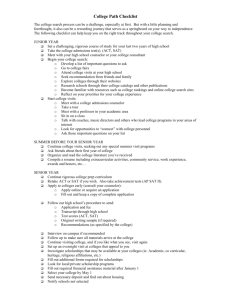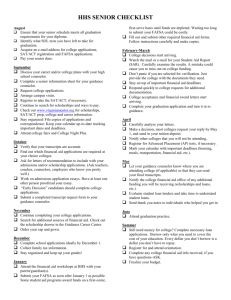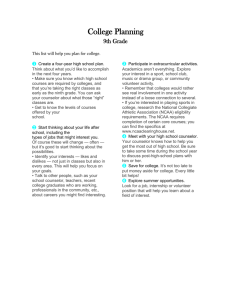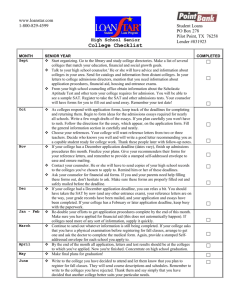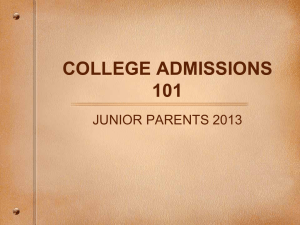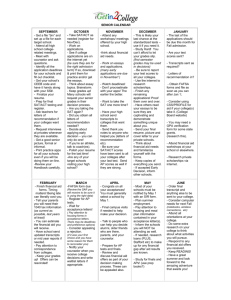Road To College - Orinda Aquatics
advertisement
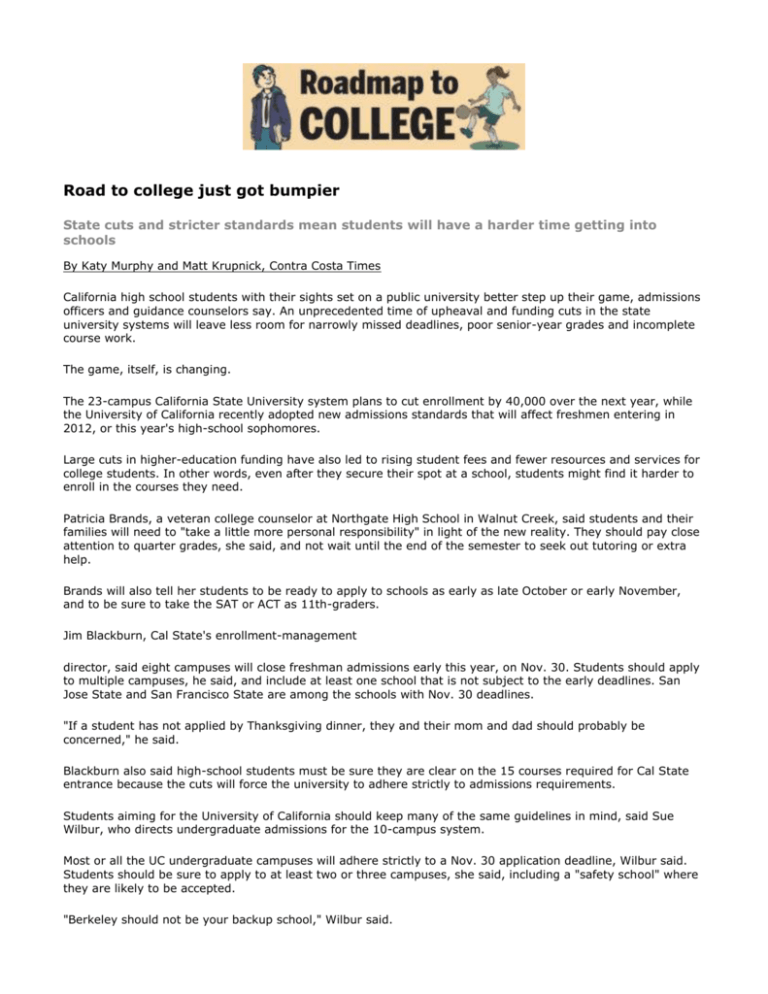
Road to college just got bumpier State cuts and stricter standards mean students will have a harder time getting into schools By Katy Murphy and Matt Krupnick, Contra Costa Times California high school students with their sights set on a public university better step up their game, admissions officers and guidance counselors say. An unprecedented time of upheaval and funding cuts in the state university systems will leave less room for narrowly missed deadlines, poor senior-year grades and incomplete course work. The game, itself, is changing. The 23-campus California State University system plans to cut enrollment by 40,000 over the next year, while the University of California recently adopted new admissions standards that will affect freshmen entering in 2012, or this year's high-school sophomores. Large cuts in higher-education funding have also led to rising student fees and fewer resources and services for college students. In other words, even after they secure their spot at a school, students might find it harder to enroll in the courses they need. Patricia Brands, a veteran college counselor at Northgate High School in Walnut Creek, said students and their families will need to "take a little more personal responsibility" in light of the new reality. They should pay close attention to quarter grades, she said, and not wait until the end of the semester to seek out tutoring or extra help. Brands will also tell her students to be ready to apply to schools as early as late October or early November, and to be sure to take the SAT or ACT as 11th-graders. Jim Blackburn, Cal State's enrollment-management director, said eight campuses will close freshman admissions early this year, on Nov. 30. Students should apply to multiple campuses, he said, and include at least one school that is not subject to the early deadlines. San Jose State and San Francisco State are among the schools with Nov. 30 deadlines. "If a student has not applied by Thanksgiving dinner, they and their mom and dad should probably be concerned," he said. Blackburn also said high-school students must be sure they are clear on the 15 courses required for Cal State entrance because the cuts will force the university to adhere strictly to admissions requirements. Students aiming for the University of California should keep many of the same guidelines in mind, said Sue Wilbur, who directs undergraduate admissions for the 10-campus system. Most or all the UC undergraduate campuses will adhere strictly to a Nov. 30 application deadline, Wilbur said. Students should be sure to apply to at least two or three campuses, she said, including a "safety school" where they are likely to be accepted. "Berkeley should not be your backup school," Wilbur said. After applying, students should keep a careful eye on their e-mail inbox for acknowledgments and important notices, she said. Regardless of whether the university decides to limit admissions next year, this year's seniors need to work hard to get into the campus of their choice, she said. "Bottom line is: Take the most challenging course load you are prepared to take," she said. "Senior year matters, so make sure you don't ease off." Blackburn also cautioned seniors not to coast through their final year of high school. It's never too early to start preparing for college, especially during these economic times. With the right steps, students and their families can stay on the path to a higher education. Tips for the college-bound: Read ours, share yours Here are tips that education reporter Katy Murphy has compiled for college-bound students and their parents. Then come back Sunday, Monday and Tuesday and read our Road To College package in print or online. We'll give you a guide that will include courses to take, resources for SAT test preparation and scholarships and more. And learn what the California budget cuts mean for your college planning. FOR STUDENTS √ Set a time to study each day. √ Find a quiet space where you can focus, either at your house or at a library or community center. √ Get involved with sports and other activities. Volunteer. √ Read for fun, especially during the summer! √ Get help to improve your academic weak points, either from your teacher or through a community tutoring program. √ D's don't cut it for most universities. If you earn a D or an F in a class, check with your teacher or a counselor about retaking it at summer school, a local community college or an adult school. FOR PARENTS AND GUARDIANS √ Make sure your child develops good study habits and attendance early on. √ Encourage him to read something every day for fun. √ Make contact with teachers within the first week of the school year — by email, phone, or in person — so they know you're interested in following your child's progress, and how to reach you. √ Look at your child's homework. If she rarely brings home work, or if it seems overly simple, check with the school to find out why. √ Each year, find out which of the classes on the schedule count toward the 15 `a-g' requirements of the UC and CSU systems. If the schedule seems light, go to the school and ask for a change. √ Throughout the year, make sure your child is on track to pass those 15 classes with a grade of `C' or above. If he's not, set up a meeting with the teacher — and your child — to find out what he can do to bring up his grade. If he receives a `D' or an `F,' find out about the "credit recovery" programs at the high school. √ Check progress reports to ensure your child is on track to earn a `C' or above. If she earns a `D,' the course doesn't count toward the college requirements. Road to college Q&A By Katy Murphy, Oakland Tribune Frank Worrell is a professor and the director of the School Psychology Program in the Graduate School of Education at UC Berkeley. His research interests include academic talent development, at-risk youths, ethnic and racial identity, and psychosocial development. Q: When should I start thinking about college? A: The best answer to this question: now. College is one more step on your academic journey that began when you entered preschool or kindergarten. There are many things you need to know and do to be eligible for college and be successful there, including taking the prerequisite courses, learning how to study independently, and believing in your potential to earn a degree. Q: What are the most important factors related to getting into college? A: Getting into college requires demonstrating that you have the academic potential it takes to succeed. Both the Cal State and University of California systems require that students take specific sets of courses to be eligible for admission. These requirements are referred to as the "A to G" courses, and each letter represents an area of study. In some cases, Cal State and UC have identical requirements — for instance, both systems require four years of English in high school and one year of visual/performing arts. In other cases, the systems differ. For example, UC recommends four years of mathematics, whereas only three years are required by Cal State. Universities also pay attention to sustained involvement and leadership in other activities such as sports, academic clubs and other hobbies. It is often better to be involved in one activity for several years and obtain a leadership position than to be involved in a different activity each year. Q: What are the most important factors related to succeeding in college? A: One of the most important is self-efficacy — that is, believing that you belong and can succeed in college. A second factor is self-regulation. Although students spend less time in classes, the workload in college is greater than in high school, and the onus is on the student to complete work and turn it in. There are seldom opportunities for extra credit. A third factor is persistence. When work is difficult, it is important to keep trying and not give up. Although it is not always obvious, other students are experiencing difficulties similar to yours. A fourth factor: being willing to ask for help when needed. Take advantage of professors' office hours, go to the review sessions with the teaching assistants, team with students to form study groups, and visit the academic assistance centers. Q: What do many students and families wish they had known sooner? A: Students and families often wish they had known about the "A to G" requirements and availability of financial aid. Students, in particular, often wish they knew more about active learning strategies and forming and using study groups well. These are useful skills to develop in middle and high school. Q: How will the latest round of higher-education cuts in California affect my chances of getting into college? A: The recent round of higher-education cuts may make it more difficult to get into the most competitive public universities. However, there are many state universities that are under-enrolled, so you should not allow these cuts to interfere with getting into college. If you take the correct courses and work hard, you will still have the opportunity to get into a college. Q: No one in my family has gone to college. How can they help me? A: Your family can help by believing in you and supporting your desire to go to college. They can provide you with the opportunity and space to study, and your parents can and should help you structure your activities so you get your academic work done. Your parents can also take you to college information fairs. At these fairs, which are held around the state, admissions officers provide information about getting into college and financing your education. Q: My high school guidance counselor is overwhelmed (or nonexistent). Who can help me get the courses I need? A: All high schools in California have a list of the courses they offer that are approved as meeting the "A to G" requirements. You should get this list of courses from your counselor or principal at the beginning of your freshman year so that you can monitor your progress, even if your counselor is not doing so. Some of these courses can also be taken at a community college, but you must ensure that any community college course that you take is transferable to Cal State or the University of California. You can also find a lot of helpful information on the UC Berkeley Web site at collegetools.berkeley.edu. This Web site has a variety of resources in English and Spanish for you, your parents and for schools. College prep to-do list COURSES YOU NEED TO TAKE The below courses, known as `A-G' requirements, must be passed with a grade of `C' or better to be eligible for UC/CSU admission. Note: Not all classes in the below subjects are A-G-approved. Find out if yours are. *A = U.S. History and Social Science - 2 years *B = English - 4 years *C = Math (Algebra I, Geometry and Intermediate Algebra) - at least 3 years, UC recommends 4 *D = Laboratory Science - 2 years, UC recommends 3 *E = Foreign Languages - 2 years, UC recommends 3 *F = Visual and Performing Arts - 1 year *G = College Preparatory Electives - 1 year WHAT TO DO IN MIDDLE SCHOOL (CHECKLIST) √ Meet with your school counselor (and a parent), and tell her your goal is to attend college. Take pre-algebra and, if possible, Algebra I and/or a world language. √ Find out if you qualify for your school's Gifted and Talented Program √ Join clubs or teams at your school √ Read something every day √ Try to earn an A or a B in all of your classes √ Put extra effort into English, math and science. √ Review your ninth-grade schedule with a parent or guardian. Make sure it includes Algebra I or geometry, college preparatory English and other `A-G'-approved classes. √ Find out whether your future high school has an AVID program. IN NINTH GRADE √ Map out a four-year class schedule with your counselor √ Take Algebra I or geometry, college prep English and other `A-G' approved courses. To be on track to graduate with the UC/CSU required classes, you need to take three to four A-G courses each school year. √ Most English language development classes don't meet the university English requirement. If you're an English learner, find out how you can catch up. √ Strive for As and Bs, and seek out extra help as soon as you need it √ Consider enrolling in the AVID program, if it's offered at your school √ Get involved in sports, extracurricular activities, or volunteering √ Start a college information folder √ Find out about summer enrichment or tutoring programs available at your school or in your neighborhood. You can get help with subjects that you find challenging, or get ahead IN TENTH GRADE √ Review your four-year scheduling plan to be sure that you are taking enough college prep courses √ Take geometry or Algebra II, college prep English and other `A-G' approved courses, such as biology or a world language √ Sign up for the Preliminary SATs (PSATs) √ Find a study guide for the California High School Exit Exam (CAHSEE), which you'll take in February or March. √ Research colleges - Consider their programs, admissions standards, tuition and location. Call, write, or email to request information. √ Visit at least one college campus √ Find out about summer enrichment or tutoring programs you can take part in IN 11th GRADE Fall √ Make sure you are still on track to graduate with the 15 `A-G' course requirements. By this point, you should have completed about six to eight A-G courses. √ Consider taking honors or Advanced Placement (AP) courses. √ Take advanced math and college prep English and other college prep courses, such as laboratory science (chemistry or physics) or social science (U.S. History). Maintain As and Bs. √ Sign up to take the PSAT in October √ Narrow your list of colleges √ Attend a College Night or a college tour. Winter √ Register for the SATs and/or the ACTs 6-8 weeks in advance. SAT schedules can be found at www.collegeboard.com. ACT information is at www.actstudent.org. Ask your counselor if you're eligible for an SAT fee waiver. √ Meet with college representatives that come to your school Spring √ Continue college visits √ Take the SAT, but be sure to take a practice test first √ Start looking for scholarships. Ask your counselor and contact community organizations (Rotary, churches/synogagues, etc.) √ Review your senior class schedule with your counselor. Consider additional honors, AP and community college courses √ Look for summer jobs, courses and volunteer opportunities Summer √ Organize list of colleges into three categories: safe, realistic and reach. √ Make a checklist of what each college needs (personal statement, transcript, letters of recommendation) √ Write a draft of your personal statement. √ Mark a calendar of important dates and deadlines for the upcoming year. √ If you plan to re-take the SAT or ACT in the fall, register for the test as soon as possible 12th GRADE Fall √ Meet with a counselor to make sure you are still on the right track √ Ask your English teacher to review your personal statement/entrance essay and provide feedback on how it might be improved √ Double-check deadlines for college applications and financial aid √ Last chance to take - or re-take - the SATs and ACTs √ Request letters of recommendation ASAP. They can be from teachers, community leaders or other adults who know you well. Give each writer a stamped, addressed envelope and the recommendation form √ November: Apply to CSU and UCs. Many private colleges also have deadlines, or priority deadlines, in November and December. √ Send SAT or ACT scores to each college, as well as a preliminary transcript √ Ask three or four people you trust to make sure that your applications are complete Winter √ December: Some scholarship applications are due √ January: Apply for the Free Application for Federal Student Aid (FAFSA) with a parent or guardian. Need help? Go to a Cash For College workshop in your area. √ February: Most financial aid deadlines √ Sign up for summer orientation or summer bridge program Spring √ March 2: Cal Grants deadline √ April: Check the mail for college decisions and financial award letters! √ May: Tell each college (that has accepted you) whether you plan to attend √ If you're wait-listed, let admissions officer know you're still interested √ Send a deposit to the school of your choice √ Look for follow-up financial aid forms from your college √ Keep up your grades and attendance √ Need to take placement exams? √ Apply to community college, if you plan to attend in the fall Summer √ Make sure your transcript is sent to the school you've chosen Checklist sources: UC Berkeley's College Tools site, CSU Mentor and Oakland school district's College and Career Readiness Office College turmoil increases need for financial planning By Matt Krupnick, Contra Costa Times Families have always agonized over how to save money for their children to attend college, but these days planning can be even more difficult. Colleges and universities have been raising fees sharply and often, making it particularly difficult for families to plan. The phenomenon also has widened the gap between low-income families who can secure enough student aid to pay for college and wealthier families who can pay for school themselves. For the middle class in particular, priorities may have to change, said Sean Connors, founder of College Planning Specialists in Concord. "They have to be realistic," Connors said. "Where can the student go? And what's realistic for the pocketbook? People generally look at one or the other. Now, more than ever, you have to be on the same page." Every family, experts said, should check its eligibility for government need-based scholarships: California's Cal Grant and the federal Pell Grant. That exploration should begin during a student's early high-school years. But grants and loans likely will not cover everything, especially if fees continue to rise. "Student loans have an annual maximum per grade level that has nothing to do with fees going up," said Barbara Hubler, San Francisco State's financial-aid director. "I think it's really very hard for middle-class families to meet that extra little bit." Families often use what are known as 529 plans — named after a U.S. tax code — that provide tax breaks on money set aside for college tuition. But, like all investments, 529 plans can be unpredictable. Students and parents need to decide whether additional costs should be covered through loans or a student job, Hubler said. "Either you borrow now and work later, or you can work now," she said. "Working isn't a bad thing, but there needs to be a balance (between work and school)." Although fees in the California State University and University of California systems are lower than those in most other states, the schools themselves do not provide as much financial help to needy students as wealthier private schools, Connors said. Contrary to conventional wisdom, he said, families unable to save money should consider more expensive colleges. "Far too many families are looking at the Cal State and UC systems and saying, 'That's the cheaper option,'" he said. "Private schools can make it much cheaper for students to go away to school." The cheapest option, however, remains California's community colleges. Even with this year's $6-per-unit fee increase, community colleges can make the first two years of college significantly more affordable, and they can also improve an academically weak student's chances of graduating from a high-quality university. "It's not a bad route to go," Connors said. "It's a viable option. In some cases, it's the only option." FINANCIAL aid RESOURCES Icanaffordcollege.com: A California Community Colleges guide to financial assistance. Go to www.icanaffordcollege.com. Cash For College: Financial aid workshops to help you and your family fill out the Free Application for Federal Student Aid, or FAFSA. Go to www.californiacashforcollege.org. East Bay Consortium: College preparation and financial aid resource for Oakland students and teachers. Go to www.eastbayconsortium.org/.
